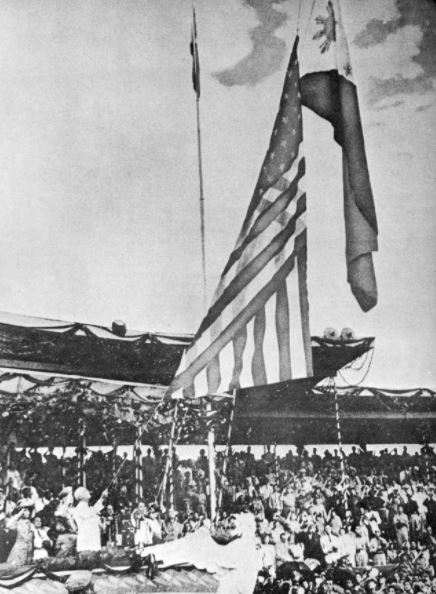After more than three years, the Filipino-American war came to an end on July 2, 1902, with a United States victory, but not without the demise of more than 4,200 American soldiers and over 20,000 combatants. Not to mention that the bloody armed conflict also resulted in the death of 200,000 civilians who perished from famine, disease, and violence.
Following its triumph in the atrocity-brimmed war, the United States was able to secure a strategic location in the Asia Pacific, both for its military and economic interests. Despite such, U.S. administrations deemed that the Southeast Asian country ultimately will gain its full independence.
In line with that, the Jones Law, or formally called the Philippine Autonomy Act, was passed in August 1916, promising the Philippine archipelago its independence as long as the Filipinos can prove to the U.S. that they finally govern themselves.
In March 1934, the Tydings–McDuffie Act, more formally known as the Philippine Independence Act was enacted, superseding the Jones Law and establishing the Philippines’ 10-year transition to becoming an independent country.
In 1935, the Commonwealth of the Philippines became operative, which had to fix various issues in social justice, national integration, cultural identity, economic improvement, labor, agrarian reform, and national defense within the transition period. Though the archipelago was devastated by World War, the United States withdrew its control over the country on July 4, 1946, formally granting independence to the Republic of the Philippines.
US and Philippines Trade Relations and Economic Negotiations
The Philippines’ economy suffered massively from World War. Thus, the flow of capital and payment for war damages were rigorously needed by the newly-autonomous republic. Two days prior to the country’s independence, the Bell Trade Act or the Philippine Trade Act was enacted by the United States Congress. It contained trade and economic policies revolving between the two countries after the U.S. granted sovereignty to the Philippines.
Part of the act was the United States’ offer to pay the Philippines $800 million as rebuilding funds if the latter will ratify the Bell Trade Act. Specific provisions include having quotas on the exports of the Philippines to the United States, setting a fixed exchange between the Philippine pesos and U.S. dollar at 2:1, having an eight-years complete free trade whilst gradually increasing tariffs over the next twenty years.
One controversial clause of the Bell Trade Act was the Parity Amendment, providing equal rights to American citizens and corporations in exploring the archipelago’s public utility operations and natural resources. As granting “parity right” was contrary to the 1935 Philippine Constitution’s Article XIII, the act required a constitutional amendment.
Though many Filipinos also objected to the said arrangement, the Congress of the Philippines passed the Bell Trade Act on July 2, 1946, two days before it gained its independence. As such, a plebiscite was approved on September 18, 1946, fulfilling the amendment required in the Philippine Constitution.
While the $800 million war damage claims seemed to be a fair reward for the Philippines’ reluctant concurrence, the Bell Trade Act became very unpopular in the country, given that it tied the Philippine economy to that of the U.S. In 1949, 80% of the entire Philippine trade was with the U.S.
Less than a decade later, the Laurel–Langley Agreement was signed to replace the Bell Trade Act, abolishing many of the provisions from the earlier contentious trade agreement and making changes more in line with the interests of the Filipinos.
As the decades progressed innumerable measures have also been passed by the Philippines to solidify its trade and economic policies. In 1970, the United States had a 40% share of the Philippine trade, and down to 27 percent in 1988. Yet, it was because new markets have also opened their doors for the exporters in the Philippines.
Nevertheless, several agreements have been signed between the Philippines and the United States to strengthen their commercial relationship that now spans over 100 years.
For instance, the Philippines passed the Electric Power Industry Reform Act in 2001, opening many opportunities for U.S. businesses to join the country’s power industry. Meanwhile, leading investment opportunities also became widely available in ICT and backroom operations, such as in shared-service centers, regional facilities, and call centers.
Jumping to 2006, merchandise trade between the two countries totaled $17.3 billion, with 16% of imports of the Philippines were sourced from the U.S., while its exports to the country was around 18%. For the U.S. the Philippines serves ranked 26th in its export markets while being its 30th largest supplier.
In 2014, the U.S.-Philippines’ goods and services trade amounted to $24 billion, with the Philippines being the United States’ 33rd biggest importer and 34th biggest supplier. In 2020, total trade was estimated to be at $25.3 billion.
Top imports of the Philippines include electrical machinery, transport equipment, leather products, optical and medical instruments, vegetable and animal fats and oils, and cereal. Meanwhile, key imports of the United States include textiles and garments, animal feeds, coconut oil, processed fruit, and vegetables, fruit and vegetable juices, raw beet and cane sugar, and tree nuts. Top Philippine service exports to the United States were under travel, telecommunication, information, and professional and management services and sectors.
The United States continues to be one of the Philippines’ largest investors, with American t companies and firms playing vital roles in the country’s economic growth and development. Recently, the Philippines government also made valuable progress and success in enacting its economic and trade policies. Thus, resulting in significant triumphs in tax revenues, intellectual property protection, debt ranking, and GDP growth. The U.S. backs those remarkable improvements by continually enhancing support and engagement to stimulate the Philippines’ further expansion.
Indeed, the trade, economic, and business engagement between the two countries have been positive and growing over a century after the Philippine-American War, and will most endure in the foreseeable future.
